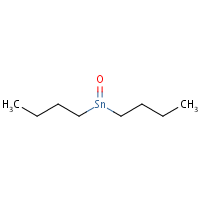Dibutyltin oxide
Agent Name
Dibutyltin oxide
CAS Number
818-08-6
Formula
C8-H18-O-Sn
Major Category
Metals

Synonyms
DBTO; Di-n-butyl-zinn-oxyd [German]; Di-n-butyltin oxide; Dibutyloxide of tin; Dibutyloxostannane; Dibutyloxotin; Dibutylstannane oxide; Dibutylstannium oxide; Kyslicnik di-n-butylcinicity [Czech]; Tin, dibutyl-, oxide; Tin, dibutyloxo-; Stannane, dibutyloxo-; [ChemIDplus] Dibutyl(oxo)stannane; [ECHA REACH Registrations] Dibutyltin(IV) oxide; [Sigma-Aldrich MSDS]
UN3146
Category
Tin Compounds, Organic
Description
White solid; [Merck Index] White powder; [Sigma-Aldrich MSDS]
Sources/Uses
Used as a catalyst in synthetic organic chemistry; [Merck Index] Used to formulate adhesives-sealants, paints-coatings-thinners, polymers, products for dying-finishing-impregnating paper-board, textiles, and leather, to make fine chemicals, textiles-leather-fur, pulp-paper-paper products, wood products, rubber products, computer-electronic-optical products, in general manufacturing, and building and construction work; [ECHA REACH Registrations] Permitted for use as an inert ingredient in non-food pesticide products; [EPA]
Comments
Corrosive to eyes in rabbits, with corneal opacity and other effects not reversed within 7 days; [EPA - TSCATS] Causes flaccid paralysis, general anesthesia, and somnolence in intraperitoneal lethal-dose studies of rats; Causes normocytic anemia in 26-week intermittent oral studies of rats; [RTECS] A skin, eye, and respiratory tract irritant; May cause CNS effects; Chronic exposure may cause liver injury; May be toxic to reproduction or development, based on animal studies; [ICSC] An irritant that may cause serious eye injury; May cause skin sensitization; Toxic by ingestion; Prolonged or repeated exposure may cause thymus injury; Suspected mutagen and teratogen (oropharyngeal malformations); [ECHA REACH Registrations] A mild skin irritant; May cause serious eye injury; Highly toxic by ingestion; Prolonged or repeated exposure may cause organ injury; Teratogenicity observed in rats; [Sigma-Aldrich MSDS] See "Tin, organic compounds."
Biomedical References
Exposure Assessment
Skin Designation (ACGIH)
Yes
TLV (ACGIH)
0.1 mg/m3, as Sn
STEL (ACGIH)
0.2 mg/m3, as Sn
PEL (OSHA)
0.1 mg/m3, as Sn
MAK
0.02 mg/m3, inhalable fraction, as Sn
IDLH (NIOSH)
25 mg/m3, as Sn
Explanatory Notes
The Guide in the Emergency Response Guidebook is for "Organotin compound, solid, n.o.s."
Adverse Effects
Skin Sensitizer
Yes
Neurotoxin
Other CNS neurotoxin
Hepatotoxin
Hepatoxic (a) from occupational exposure (secondary effect) or (b) in animal studies or in humans after ingestion
Reproductive Toxin
Yes
Diseases, Processes, and Activities Linked to This Agent
Diseases
Occupational diseases associated with exposure to this agent:
Processes
Industrial Processes with risk of exposure: